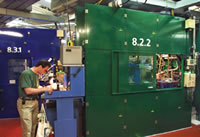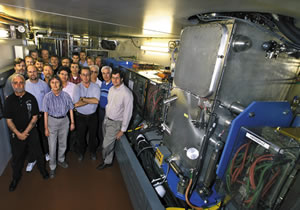|
|
|
 |
|
|
| |
 |
|
| Beamline 8.3.1, at left,
is the first of the superbend protein crystallography
beamlines, constructed by the ALS Experimental Systems
Group in collaboration with the ALS Engineering Group
for a UC Berkeley-UC San Francisco consortium. |
|
|
|
|
|
The ALS is a synchrotron-type particle accelerator designed
to accelerate electrons to energies as high as 1.9 billion
electron volts (GeV), focus them into a tight beam, and send
this beam around the curved path of a storage ring for several
hours. While in this storage ring, intense beams of photons
are extracted from the electron beam through use of either
bending, wiggler, or undulator magnetic devices.
Originally, the ALS was optimized to extract ultraviolet and
x-ray photons in the 10 to 1,500 electron-volt range, but
with the installation of the new superbends it can now produce
x-rays at energies up to 40,000 electron volts. This is because
the "superbends" are superconducting magnets with
a field strength of 5 Tesla, which is about four times stronger
than the field strength of the conventional bend magnets they
replaced.
Replacing three of the 36 conventional bend magnets with
superbends posed major technical challenges for the superbend
project team, which was under the leadership of accelerator
physicist David Robin and included, from Berkeley Lab, members
of the ALS Accelerator Physics group, the Superconducting
Magnet group of the Accelerator and Fusion Research Division,
the Engineering Division, and the ALS Project Management group.
Compounding every hurdle that the superbend team faced was
the need to not compromise in any way the ALS's outstanding
capabilities, already established, in the extreme ultraviolet
and soft x-ray regions.
|
|
| |
 |
 |
|
| |
The superbend project team
stands next to one of three superbend magnets. The team
included members from the Berkeley Lab ALS Accelerator
Physics group, the Superconducting Magnet group of the
Accelerator and Fusion Research Division, the Engineering
Division, and the ALS Project Management group. |
|
|
"What this meant was that our team was tasked with transitioning
in a relatively short period (six weeks for installation and
commissioning) to superbend operation with no impact on beam
lifetime, photon brightness, reliability, or stability,"
Robin says. "This was especially tough because the superbend
systems are an essential component of the ALS. A superbend
failure would mean failure for the entire facility."
The idea of retrofitting the ALS with superconducting bend
magnets was conceived in the early 1990s, and a prototype
magnet coil was built and tested in 1997. Based on the success
of this prototype, the superbend study became an offical project
with Robin at the helm in 1998. Knowing that once they began
the actual installation, work would have to proceed quickly
with little margin for error, the ALS superbend team planned
very carefully, studying every aspect of the proposed retrofit,
from beam dynamics to the cryosystem, to the spatial restrictions
of the ring, to the timing of the installation shutdown.
The careful planning paid off, as Robin explains. "It
was major surgery of the machine. Everything needed to work
right away and it did. For ALS users of soft x-rays, the transition
from pre- to post- superbend operation has been transparent.
However, for ALS users who take advantage of the superbends,
the impact has been tremendous."
The primary reason for retrofitting the ALS with superbends
was to help meet the huge demand for protein crystallography.
Sending an intense beam of x-rays through a protein crystal
creates a set of diffraction patterns that can be translated
by computer into 3-D images with atomic-scale resolution of
the protein's structure. Of the thousand-plus users of ALS
photons, over a fourth do their research at the Macromolecular
Crystallography Facility, one of the top experimental facilities
in the world for determining protein crystal structures. Yet
the waiting line for would-be users continues to swell.
|
| "For ALS
users who take advantage of the superbends, the impact
has been tremendous." |
|
Consequently, six of the 12 experimental beamlines that
will eventually be served by the three new superbend magnets
are slated to be used for protein crystallography. Three of
these, one funded by a collaboration of the University of
California campuses at Berkeley and San Francisco, and two
by the Howard Hughes Medical Institute, are already up and
running and making contributions.
Of the remaining superbend beamlines, one will be used in
conjunction with diamond anvil cells to do high-pressure studies
of materials that have been condensed to nanometer sizes,
and the other will most likely be devoted to tomography for
obtaining high-resolution 3-D images of the internal structures
of nanoscale objects. For the final beamline, application
possibilities include microfocus diffraction and spectroscopy.
This is the first-ever retrofit of superbends into the storage
ring of an operating synchrotron radiation source. To date,
against all odds, there has no been no noticeable degradation
in the performance of the ALS, nor any facility down-time
as a result of the retrofit.
Says project leader Robin, "I am extremely proud of
the accomplishments of the superbend team members. It was
really an extraordinary achievement."
-- Lynn Yarris
|



